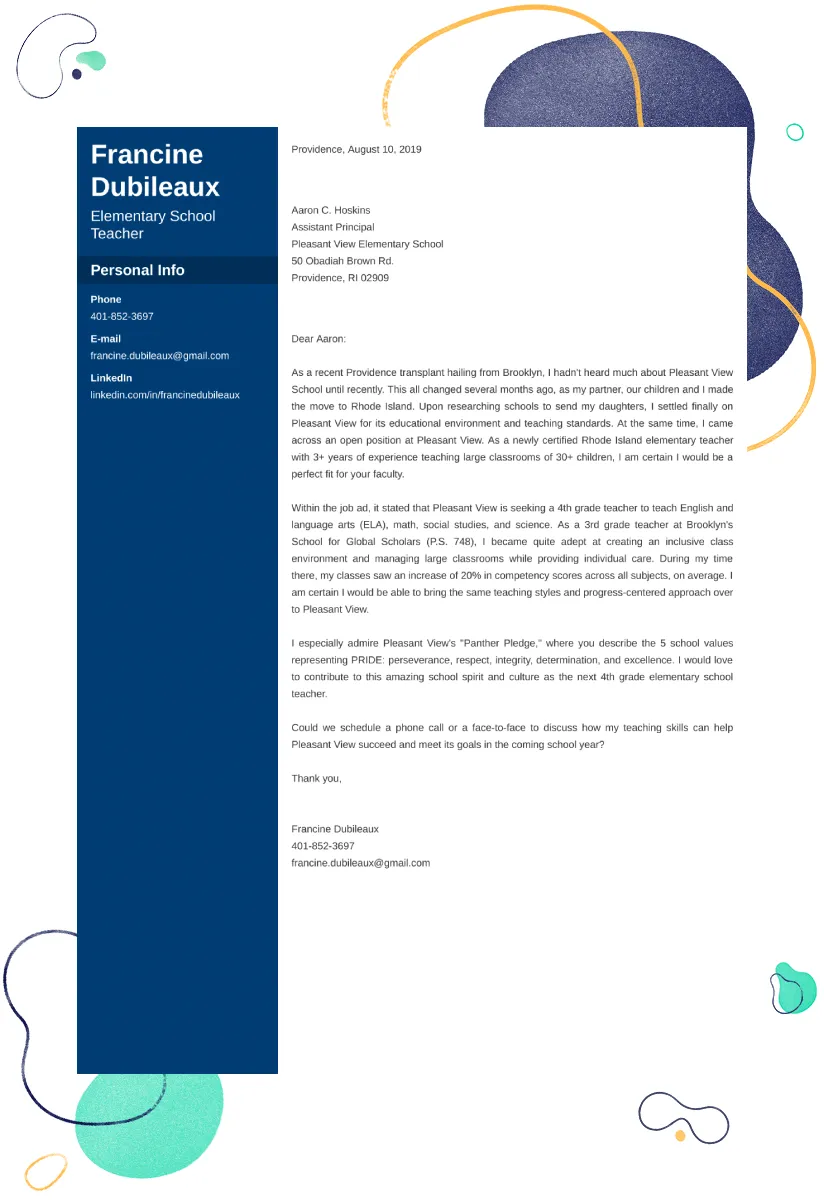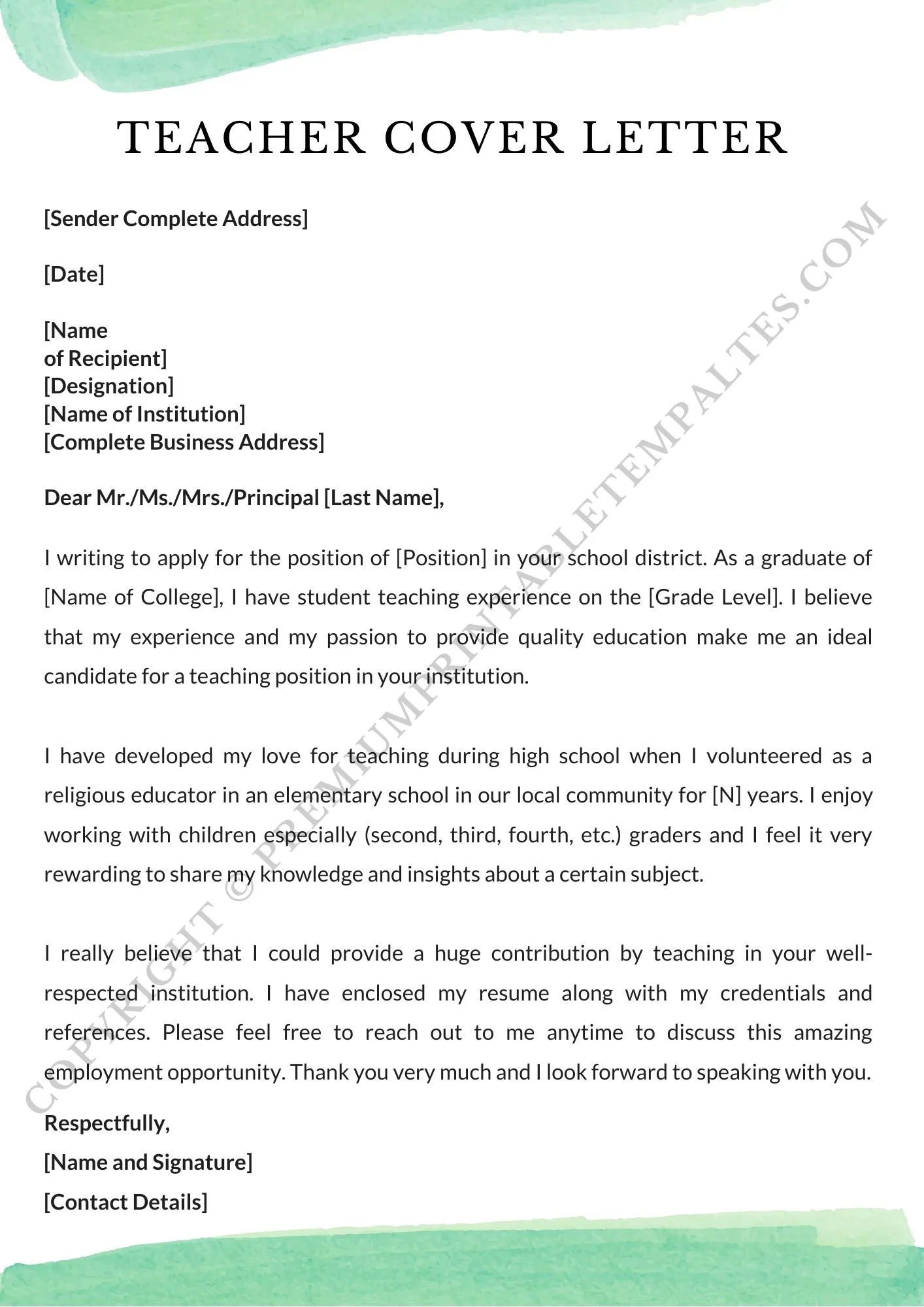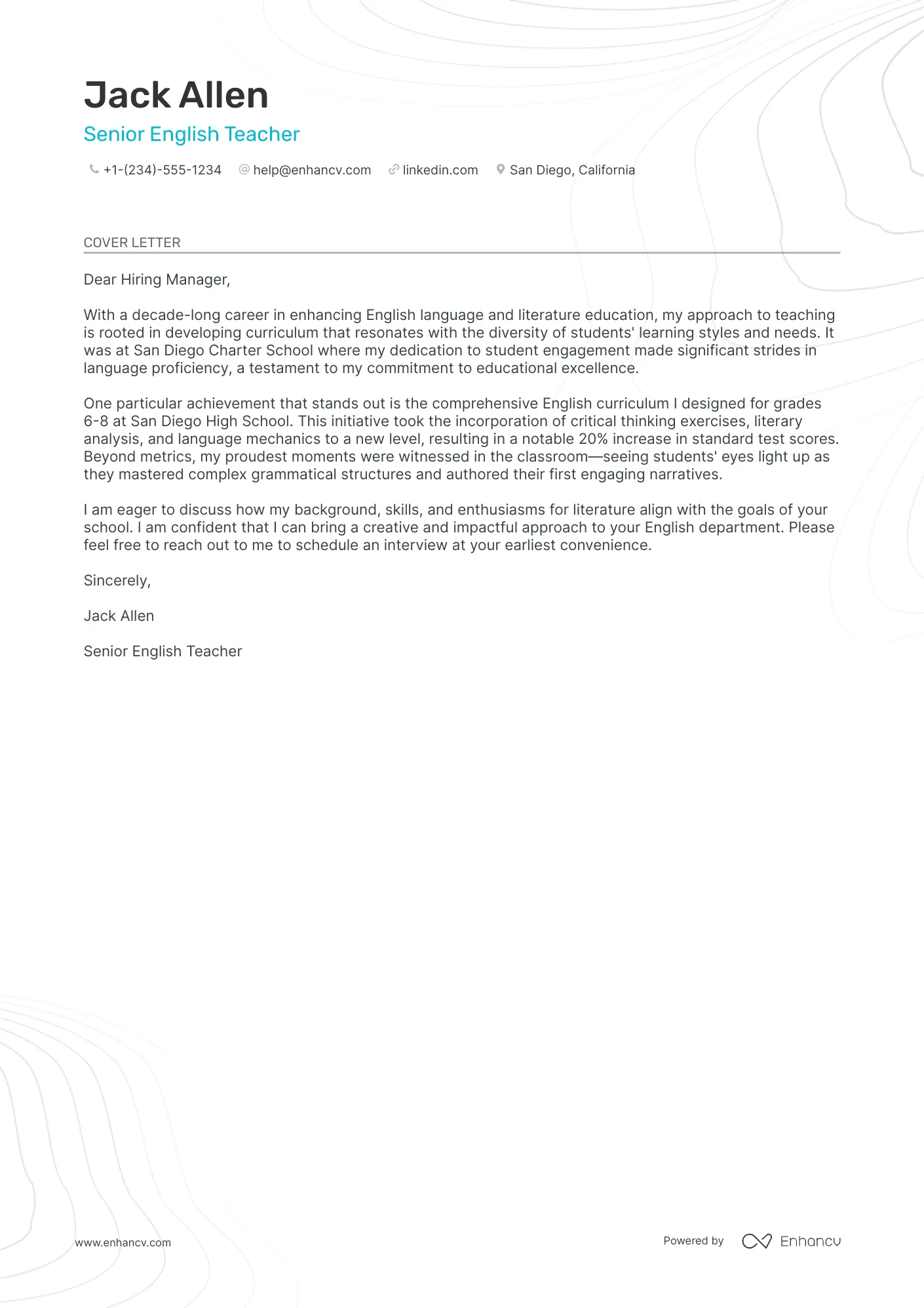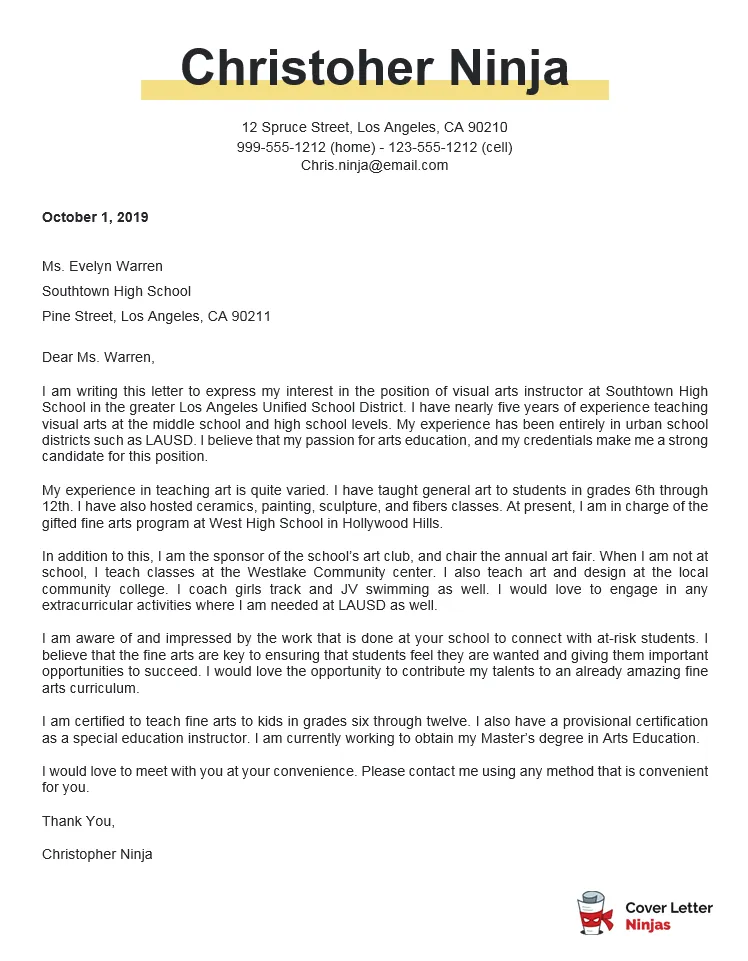Why a Strong Cover Letter Matters for New Teachers
For new teachers, a cover letter is not just a formality; it’s your first chance to make a lasting impression. It’s your introduction, your sales pitch, and your opportunity to show a hiring committee that you’re more than just a list of qualifications on a resume. In a competitive job market, a well-crafted cover letter can set you apart from other applicants, demonstrating your enthusiasm, skills, and personality. It provides context to your resume, allowing you to elaborate on your experiences and connect them to the specific needs of the school. This is where you can paint a picture of yourself as a dedicated, passionate, and capable educator, ready to make a positive impact in the classroom and the school community. A compelling cover letter can transform your application from a simple submission to a standout statement of your potential.
Highlighting Your Teaching Skills
Your cover letter is the perfect platform to showcase your core teaching skills. Rather than just listing these skills, provide specific examples of how you’ve utilized them in the past. Use the STAR method (Situation, Task, Action, Result) to detail a situation where you demonstrated these skills and the positive outcome. For instance, instead of simply stating “I am proficient in classroom management,” describe a specific scenario where you successfully managed a challenging classroom situation, such as implementing a new behavior management system that improved student engagement and reduced disruptions. This approach gives tangible proof of your abilities and makes your claims more credible and convincing. Always tailor these examples to the specific requirements mentioned in the job description, highlighting the skills the school is looking for in its new teachers. Remember, concrete examples resonate more powerfully than vague statements.
Classroom Management

Discuss specific classroom management strategies you’ve employed. Detail how you establish clear expectations, create positive relationships with students, and foster a respectful learning environment. Mention any techniques you use to proactively address behavioral issues and maintain a productive classroom atmosphere. For example, describe how you utilize visual aids, routines, and positive reinforcement to encourage desired behaviors. If you’ve implemented a specific program or system (like PBIS), provide details on its effectiveness and your role in its implementation. Show your understanding of the importance of a structured and supportive environment for student success, and showcase your ability to create such an atmosphere.
Curriculum Development
Highlight any experience you have with curriculum development or lesson planning. Discuss your ability to create engaging and effective lesson plans that align with educational standards. Showcase your ability to differentiate instruction to meet the diverse needs of students, and mention any experience with incorporating technology into your lessons. Share examples of innovative lessons or units you’ve developed, emphasizing how you aligned them with learning objectives and student needs. If you’ve collaborated with other teachers or departments on curriculum projects, be sure to mention that, as it demonstrates your teamwork skills and commitment to curriculum improvement.
Differentiation and Inclusion
Emphasize your ability to differentiate instruction to meet the needs of all learners, including students with special needs and those from diverse backgrounds. Describe strategies you use to create an inclusive classroom environment where every student feels valued and supported. This could involve using different teaching methods, providing varied learning materials, or modifying assessments to accommodate individual learning styles and needs. Demonstrate your understanding of the importance of cultural sensitivity and your commitment to creating a welcoming and equitable classroom for all students. Give specific examples of how you have adapted lessons or provided support to individual students, showing your commitment to ensuring all students can achieve their full potential.
Showcasing Your Experience

Use the cover letter to elaborate on your previous teaching experiences, including student teaching, internships, and any other relevant roles. Focus on the skills and experiences most relevant to the job description. Don’t just list your responsibilities; explain how your work positively impacted students and the school. Quantify your achievements whenever possible, such as by mentioning improvements in student test scores or increased student engagement. If you have any experience working with specific age groups, subjects, or educational models, highlight those to show your fit for the specific position. Use this section to demonstrate a clear career trajectory and a passion for education. Provide specific instances that show your adaptability, resilience, and commitment to student success, which are attractive qualities for potential employers.
Student Teaching and Internships
Describe your student teaching or internship experiences in detail. Mention the grade level, subject, and school environment. Provide specific examples of your responsibilities, such as lesson planning, classroom management, and assessment. Highlight any challenges you overcame and the lessons you learned. Discuss how you collaborated with mentor teachers and the positive impact of your contributions. Focus on what you gained from the experience. Did you improve any teaching methodologies, or did you implement any innovative approaches that benefited students? Use this opportunity to show how you applied your theoretical knowledge in a real-world classroom setting and how you developed the skills necessary to be an effective teacher.
Volunteer Work and Extracurriculars
Include any volunteer work or extracurricular activities that demonstrate your commitment to education and community involvement. This could include tutoring, coaching, or participating in educational initiatives. Highlight any leadership roles you’ve held and the skills you developed, such as teamwork, communication, and problem-solving. Mention any experience you have working with children outside the classroom setting, as this can show your ability to connect with students on a personal level. Be sure to explain how these experiences have shaped your perspective on teaching and your ability to support student success. This is also a great place to share any awards, honors, or recognition you have received for your service or contributions.
Tailoring Your Letter to the School

One of the most crucial aspects of a successful cover letter is tailoring it to the specific school and position. Generic cover letters rarely impress hiring managers. Instead, demonstrate that you’ve done your research and understand the school’s unique culture, values, and needs. Personalize your letter by addressing the specific requirements outlined in the job description and aligning your skills and experience with those needs. This shows that you’ve thoughtfully considered the role and are a good fit for the school community. The extra effort shows your genuine interest in the role.
Researching the School’s Mission and Values
Before writing your cover letter, thoroughly research the school’s mission statement, values, and any recent initiatives. Visit the school’s website, read its social media pages, and, if possible, talk to current teachers or administrators. Demonstrate your understanding of the school’s philosophy and goals by incorporating them into your letter. Show how your teaching style and values align with those of the school. For example, if the school emphasizes project-based learning, highlight your experience with this teaching method. If the school values community involvement, discuss your relevant volunteer experiences. Aligning your cover letter to the school’s mission shows that you are a thoughtful candidate and a cultural fit.
Addressing the Specific Job Requirements
Carefully read the job description and identify the key skills, qualifications, and experiences the school is seeking. Address each requirement in your cover letter, providing specific examples to demonstrate that you possess those qualities. Use the same keywords and phrases as the job description, but don’t just repeat them. Instead, weave them naturally into your narrative, showing how your experience and skills directly meet the school’s needs. If the job description emphasizes a specific subject or grade level, make sure to highlight your relevant experience. When in doubt, address it. The more specific you are, the better. The more you’re able to show a fit, the higher your chances of getting an interview.
Formatting and Style Tips

The format and style of your cover letter are crucial for making a professional impression. Keep your cover letter concise and easy to read, using clear language and avoiding jargon. Use a professional font, such as Times New Roman or Arial, and ensure consistent formatting throughout. Proofread your cover letter carefully for any grammatical errors or typos. A well-formatted and error-free cover letter demonstrates attention to detail, which is a critical trait for a teacher. Ensure your letter is well-organized and logically structured, with a clear introduction, body, and conclusion. This organization will help the hiring manager to easily understand your key qualifications and experiences.
Choosing the Right Tone
Your tone should be enthusiastic, professional, and respectful. Show your genuine interest in the position and the school. Avoid sounding overly casual or informal. Use positive language and focus on your strengths and accomplishments. Reflect the school’s culture in your writing style. Is the school known for a formal atmosphere, or does it have a more relaxed feel? Tailor your tone to match the school’s culture, but always maintain a level of professionalism. If appropriate, inject a bit of your personality to help your letter stand out. Keep it positive and avoid sounding negative or critical. Remember, your cover letter should make the reader want to meet you.
Proofreading and Editing
Proofreading and editing are essential steps in the cover letter writing process. Errors in grammar, spelling, and punctuation can undermine your credibility and make a negative impression. After you’ve written your cover letter, take a break from it, and then read it again with fresh eyes. Read it aloud to catch any awkward phrasing or grammatical mistakes. Ask a friend, family member, or career advisor to review your cover letter for errors and provide feedback. Ensure that the letter flows logically and effectively communicates your key qualifications. Consider using grammar-checking tools, but don’t rely on them entirely. It’s also wise to proofread your cover letter multiple times, as you may catch different errors each time. Attention to detail is a critical attribute for a teacher, and a polished cover letter reflects that attribute.
Call to Action

Your cover letter should always end with a clear call to action, encouraging the hiring manager to contact you for an interview. Express your interest in the position and the opportunity to discuss your qualifications further. Reiterate your enthusiasm for the school and the opportunity to contribute to its mission. Make it easy for the hiring manager to contact you by including your contact information. Providing an invitation to contact you is the most direct way to secure an interview. By ending with a strong call to action, you make it easy for them to move forward with your application. Demonstrate a willingness to discuss your skills and experience in detail, and to answer any questions they may have.
Requesting an Interview
In your call to action, explicitly request an interview. Express your eagerness to learn more about the position and the school. Reiterate your interest and your belief that you are a good fit for the role. Phrase it professionally and politely, such as, “I am very interested in this position, and I would welcome the opportunity to discuss my qualifications further in an interview.” or “Thank you for your time and consideration. I am eager to learn more about this opportunity and would welcome the chance to discuss my qualifications in an interview.” Make sure your tone is enthusiastic but not overly aggressive. This signals your readiness to engage and discuss your qualifications further.
Following Up
After submitting your cover letter and resume, it’s acceptable to follow up with the hiring manager to reiterate your interest and ensure your application was received. Send a brief email a week or two after the application deadline, thanking the hiring manager for their time and attention. Mention your enthusiasm and reiterate your interest in the position. Keep it brief and professional, avoiding any pressure. If you haven’t heard back within a reasonable time, you can send a follow-up email or make a brief phone call to inquire about the status of your application. Showing initiative can make you stand out. Remember that persistence and professionalism are key elements in the job search process. A polite follow-up can show your continued interest in the position.
